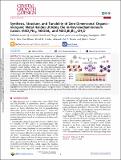Files in this item
Synthesis, structure and tunability of zero dimensional organic-inorganic metal halides utilising the m-xylylenediammonium cation: MXD2PbI6, MXDBiI5, and MXD3Bi2Br12·2H2O
Item metadata
| dc.contributor.author | Klee, Pia | |
| dc.contributor.author | Hirano, Yuri | |
| dc.contributor.author | Cordes, David B. | |
| dc.contributor.author | Slawin, Alexandra M. Z. | |
| dc.contributor.author | Payne, Julia | |
| dc.date.accessioned | 2022-05-03T08:30:09Z | |
| dc.date.available | 2022-05-03T08:30:09Z | |
| dc.date.issued | 2022-04-28 | |
| dc.identifier | 279047278 | |
| dc.identifier | d402b2d4-03e5-44fa-bdbd-6b907a285068 | |
| dc.identifier | 85130072106 | |
| dc.identifier | 000821429200001 | |
| dc.identifier.citation | Klee , P , Hirano , Y , Cordes , D B , Slawin , A M Z & Payne , J 2022 , ' Synthesis, structure and tunability of zero dimensional organic-inorganic metal halides utilising the m-xylylenediammonium cation: MXD 2 PbI 6 , MXDBiI 5 , and MXD 3 Bi 2 Br 12 ·2H 2 O ' , Crystal Growth & Design , vol. Articles ASAP . https://doi.org/10.1021/acs.cgd.2c00187 | en |
| dc.identifier.issn | 1528-7483 | |
| dc.identifier.other | ORCID: /0000-0002-9527-6418/work/112333134 | |
| dc.identifier.other | ORCID: /0000-0002-5366-9168/work/112333225 | |
| dc.identifier.other | ORCID: /0000-0003-3324-6018/work/112333835 | |
| dc.identifier.uri | https://hdl.handle.net/10023/25269 | |
| dc.description | JLP thanks the University of St Andrews for funding and the Carnegie Trust for a Research Incentive Grant (RIG008653). We thank EPSRC for funding (EP/T019298/1 and EP/R023751/1). | en |
| dc.description.abstract | Over the past decade, the efficiency of photovoltaic devices based on CH3NH3PbI3 have dramatically increased. This has driven research efforts in all areas, from the discovery of materials to film processing to long-term device stability studies. Here, we report the synthesis and structure of three new “zero dimensional” organic–inorganic metal halides which use the meta-xylylenediammonium (MXD) cation: MXD2PbI6, MXDBiI5, and (MXD)3Bi2Br12·2H2O. The different structures of the new materials lead to compounds with a range of band gaps with MXDBiI5 having the lowest at 2.15 eV. We have explored the tunabilty of MXDBiI5 through halide substitution by preparing a series of samples with composition MXDBiI5–xBrx and determined the halide content using energy dispersive X-ray spectroscopy. A large range of solid solution is obtained in MXDBiI5–xBrx, resulting in the formation of single-phase materials for bromine contents from x = 0 to 3.71 (iodine contents from 1.29 to 5). This highlights the fact that zero-dimensional organic–inorganic halides are highly tunable, in a similar manner to the higher-dimensional perovskite counterparts. Such new materials open up the opportunity for further studies of the physics and optoelectronic properties of these materials. | |
| dc.format.extent | 9 | |
| dc.format.extent | 7631653 | |
| dc.language.iso | eng | |
| dc.relation.ispartof | Crystal Growth & Design | en |
| dc.subject | QD Chemistry | en |
| dc.subject | DAS | en |
| dc.subject | SDG 7 - Affordable and Clean Energy | en |
| dc.subject.lcc | QD | en |
| dc.title | Synthesis, structure and tunability of zero dimensional organic-inorganic metal halides utilising the m-xylylenediammonium cation: MXD2PbI6, MXDBiI5, and MXD3Bi2Br12·2H2O | en |
| dc.type | Journal article | en |
| dc.contributor.sponsor | EPSRC | en |
| dc.contributor.sponsor | EPSRC | en |
| dc.contributor.institution | University of St Andrews. Institute of Behavioural and Neural Sciences | en |
| dc.contributor.institution | University of St Andrews. School of Chemistry | en |
| dc.contributor.institution | University of St Andrews. EaSTCHEM | en |
| dc.identifier.doi | 10.1021/acs.cgd.2c00187 | |
| dc.description.status | Peer reviewed | en |
| dc.identifier.grantnumber | EP/R023751/1 | en |
| dc.identifier.grantnumber | EP/T019298/1 | en |
This item appears in the following Collection(s)
Items in the St Andrews Research Repository are protected by copyright, with all rights reserved, unless otherwise indicated.

